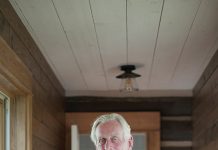What happens when a writer and artist, both passionate about architecture, come together? You get a stunning book that creatively depicts some of the most amazing Art Deco high-rises across the United States â including six iconic structures in Michigan.ÌýÌý
is a 10- by 15-inch coffee table book that features 100 Art Deco high-rises from 49 cities in 25 states.
As residents of Philadelphia and Pittsburgh, Pennsylvania, designer and visual artist Chris Hytha and writer Mark Houser grew an appreciation for the Art Deco skyscrapers in their respective cities, such as The Drake building and Gulf Tower. Unfortunately, if you donât live there, they say youâve likely never heard of them. So, in order to bring awareness to the countless Art Deco skyscrapers that are often overlooked, the duo set out on a journey across the U.S. to highlight their stories and display their designs with innovative imagery.
âThe point of this project and this book is to show the world that there are these terrific, interesting skyscrapers with fascinating histories, not just in New York, not just in Chicago, certainly there, but also everywhere else, too,â Houser said, adding he and Hytha were particularly impressed by the Art Deco high-rises in Michigan.
âIn our travels across America, I canât think of too many cities that can compete with Detroit for its collection of really terrific, especially Art Deco, historic skyscrapers.â
The six Michigan high-rises featured in the book include Olds Tower in Lansing, Union and Peoples in Jackson, and Detroitâs David Stott, Penobscot, Guardian, and Fisher Buildings. Of the six, Houser and Hythaâs favorite is the Guardian â a 40-story high-rise that opened in 1929.
âHands down, the most explosively colorful interior,â Houser said. âI have been calling it the throne room for the Queen of Legos.â
As the book notes, the Guardian Building was designed by architect Wirt Rowland, whose inspiration stemmed from his trip to Barcelona where visited the explosively colorful Sagrada Familia church. As a result, Rowland chose to incorporate vivid colors and patterns throughout the buildingâs exterior and interior, including the barrel-vaulted lobby ceiling designed with Aztec patterns and tile from Detroitâs century-old Pewabic Pottery.
In Hythaâs and Houserâs opinion, the only other interior thatâs comparable to the Guardian is Buffalo City Hall in Buffalo, New York.
âI would put that and the Guardian as the two best Art Deco interiors of almost 200 skyscrapers we visited,â Houser said. âThey both feel like a comic book, kind of, when you go inside.â
To capture the beauty of 100 Art Deco high-rises, Hytha used a drone to take a photo of each floor of the building, either at sunrise or sunset. Then, he stitched them together to create a flattened scan similar to an orthographic architectural elevation drawing, resulting in vibrant imagery that showcases the interesting details of each building.
Depending on the state of the high-rise, Hytha would alternate his editing tactics to showcase its best representation.
ÌýâSometimes I do like to remove modern antennas and all the garbage that has happened in the past 100 years and show how it was kind of intended,â Hytha said. âOther times, I kind of liked to see how these old buildings adapted and changed over time⦠sometimes, thatâs an interesting look.â
To bring their book to print, Hytha and Houser launched a $20,000 last summer, doubling their goal amount within a month.
âIt actually made us go from our original concept of 80 buildings to⦠Weâll make it 100 buildings,â Houser said. âItâs gotten really good reception from the public, and weâre excited to sell more books and share our art with more people.â
Highrises Art Deco: 100 Spectacular Skyscrapers from the Roaring â20s to the Great Depression is now available to order at .
Three Featured Michigan Buildings
Take a closer look at three of the six Michigan buildings that Hytha and Houser showcased in their book.
Fisher BuildingÌý
Funded by the Fisher Brothers and designed by renowned architect Albert Kahn, the Fisher Building is known asÌýâDetroitâs Largest Art Project.â The Art Deco building was completed in 1928, revealing a 441-foot structure designed with a marble-clad exterior and symbolic murals that represent the United Statesâ wealth, power, culture, and civilization.
The building is home to the Fisher Theater and several stores, including the Peacock Room, Pure Detroit, and Promenade Artisans Foods.
Penobscot
The 565-foot building opened in 1928 and reigned as the tallest building in Detroit for 50 years until the 729-foot Renaissance Center opened. Located by Campus Martius, the Penobscot building is decorated with stunning sculptures of Native American figures that were created by architectural sculptor Corrado Parducci, who created similar designs for Detroitâs Buhl and Guardian buildings.
A recognizable feature of the Penobscot is the red blinking orb at the top, which was once rumored to be a dirigible port but later confirmed to be an aviation beacon. When itâs on, it can be seen 40 miles away.
Olds Tower
Now known as the Boji Tower, a few years after acquiring new ownership, the historic structure stands 23 stories high and sits next to Michiganâs state capitol.
It opened in 1931 and features a huge, arched entrance made of brick and terracotta with details similar to Renaissance-styled archways made of stone. Inside, guests will find gold elevator doors engraved with designs that reflect Michiganâs labor and industry.
|
| Ìý |
|








